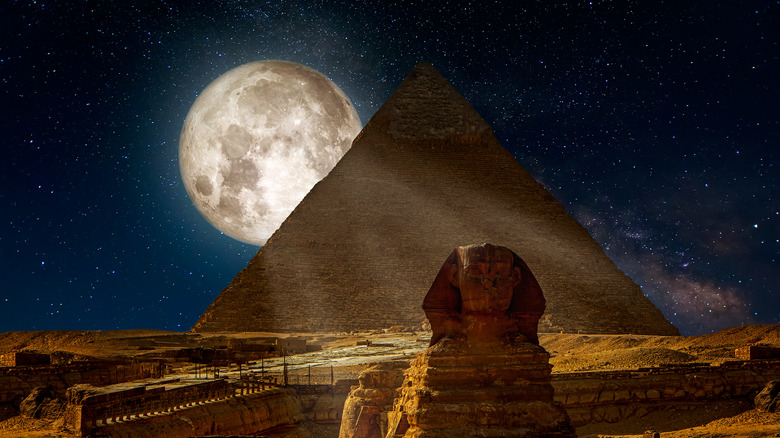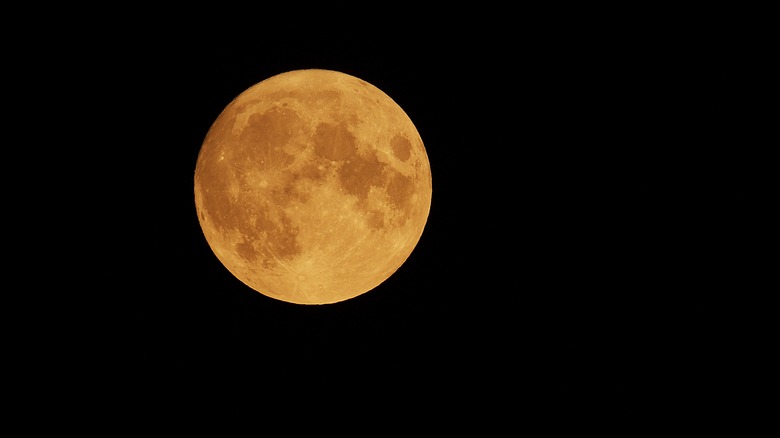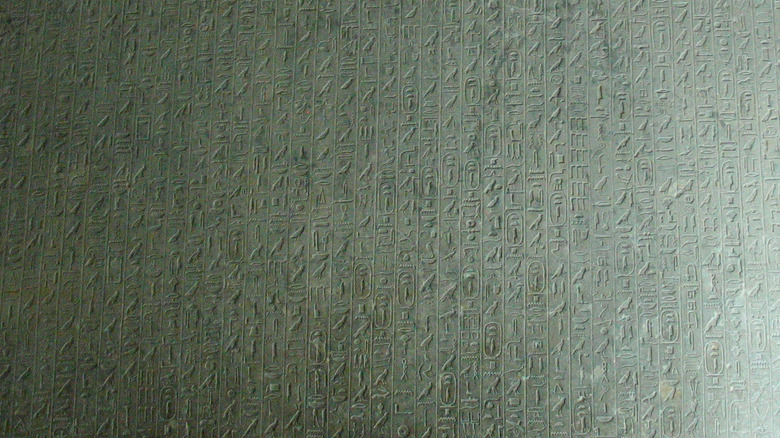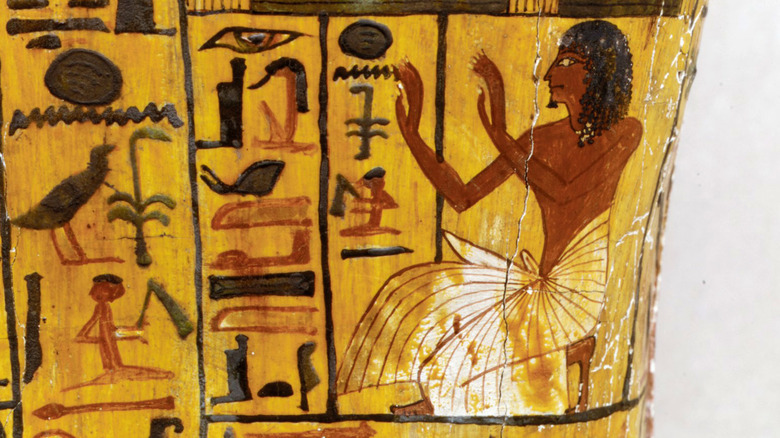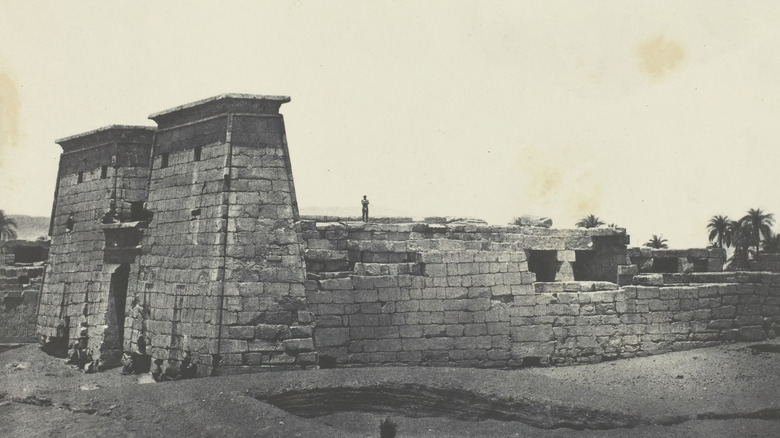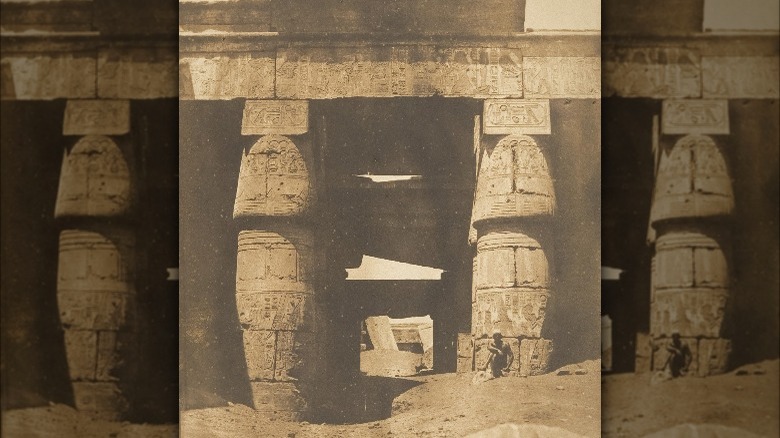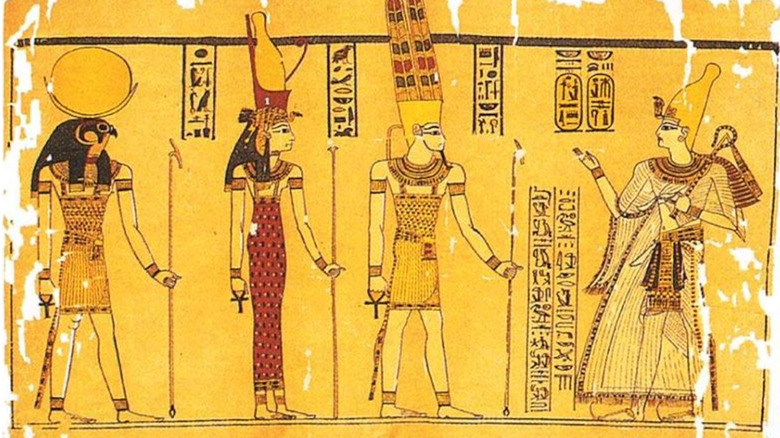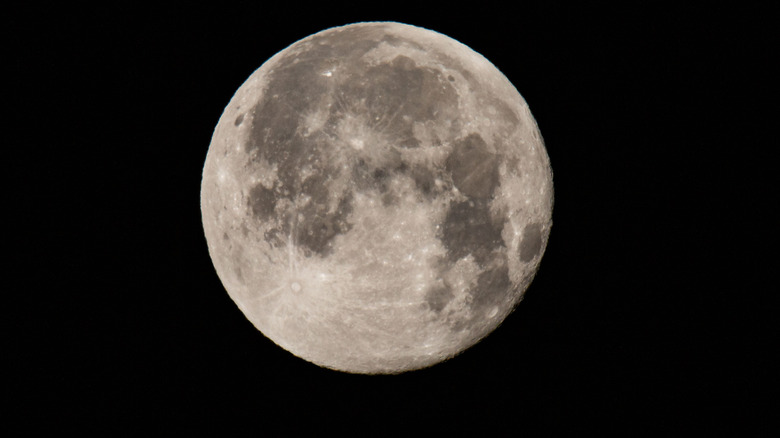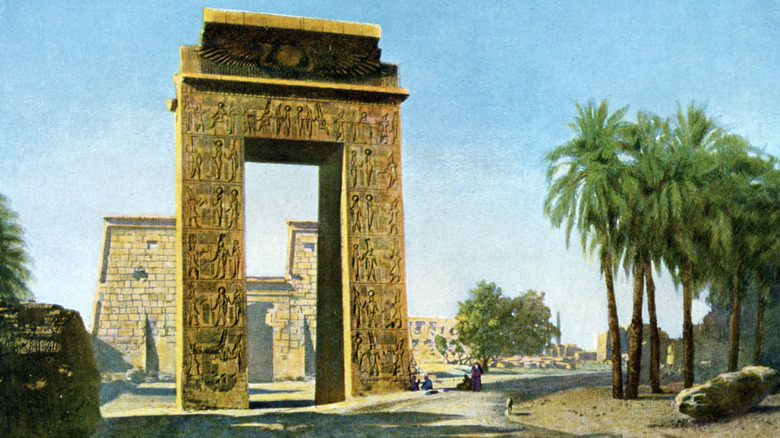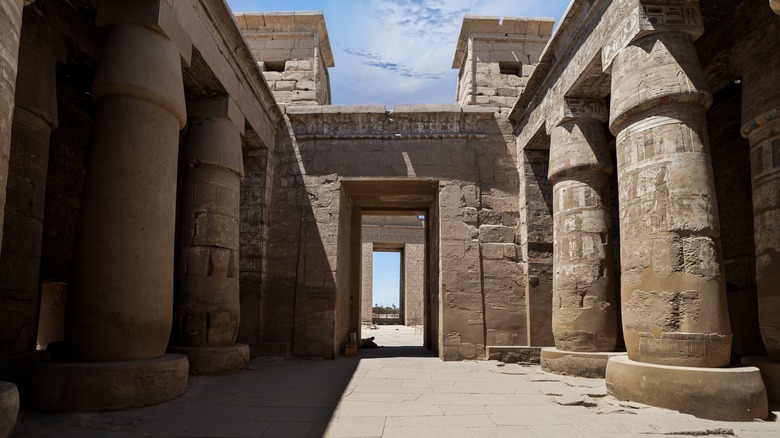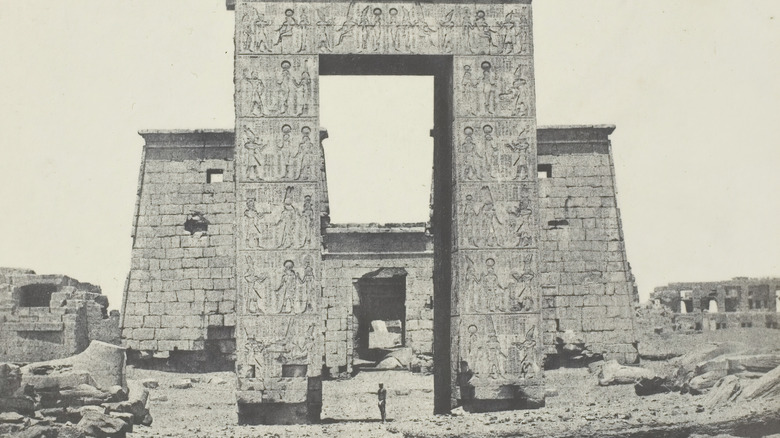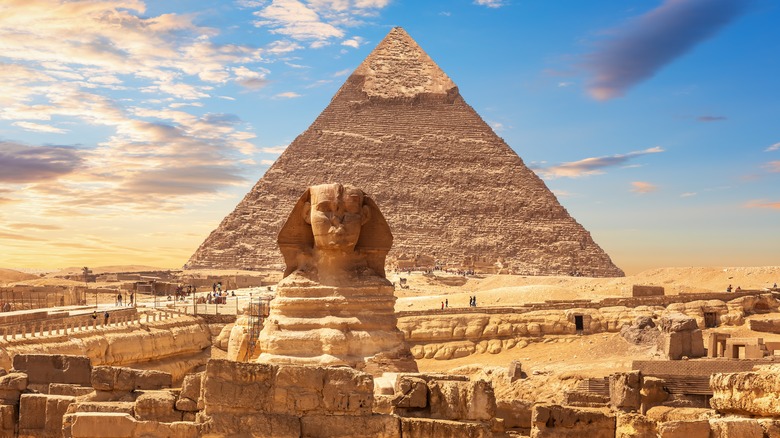Khonsu: The Legend Of The Ancient Egyptian Moon God Explained
Like many ancient cultures, the Ancient Egyptians had an expansive pantheon of gods, and one of the most interesting among them is Khonsu, the god of the moon. He's most recently been popularized by Marvel's "Moon Knight" as Khonshu, but his true legacy is a complex mythology going back thousands of years. Even his name, as Britannica notes, isn't straightforward and is also written as Khons, Chons, and Khenzu. As Egyptologist Mariam Alfy explains, Khonsu's name comes from the word "khenes" and refers to the moon's journey across the sky, but he was much more than simply a moon good. Among the Egyptians, Khonsu was also associated with time, healing, and fertility. He also had a darker side and is described in a set of ancient funerary spells known as the Coffin Texts as a devourer of hearts.
That may all seem a little contradictory, and a big reason is because of Khonsu's long history — he's among the oldest of Egypt's gods. The Ancient Egyptian civilization lasted for over 3000 years, so there was plenty of time for legends behind gods like Khonsu to grow and evolve with the ages. While his origins are lost to time, the oldest known references to Khonsu go back to at least 2350 B.C., so he was a part of Egyptian culture for most of their history (via "Egyptian Gods & Goddesses"). The result is that he's a complicated figure in Egyptian mythology, with multiple roles and several alternate identities.
The Face of the Moon God
Khonsu is usually shown in a couple of different ways, but he's nearly always depicted wearing a moon disk above his head, nestled inside a crescent. As Ancient Egypt Online explains, Khonsu was usually visualized as a young man in the posture of a mummy. He would be shown with the curved beard normally worn by gods and also a sidelock of hair, which was usually worn by children in Ancient Egypt — something that may be familiar to anyone who's seen DreamWorks' movie "The Prince of Egypt." In his hands, Khonsu is usually shown holding a crook and flail, which were symbols of kingly power and majesty (via World History Encyclopedia). These were mostly associated with the god Osiris as agricultural implements that symbolized his rule over the land. Their presence in Khonsu's hands shows he was a noteworthy figure in the Egyptian religion.
Like some other gods, Khonsu is also often shown with a falcon's head. This depiction of Khonsu is very similar to images of the sun god Ra, making it easy to get the two confused. The main difference between them is that Ra wore a sun disk on his head, slightly different in shape from Khonsu's moon.
The Terrifying Khonsu of the Old Kingdom
The oldest forms of Khonsu are his most bloodthirsty, spoken of in some of the oldest writing that survives from Ancient Egypt (or anywhere for that matter). Inscribed on the inner walls of Egypt's pyramids are the Pyramid Texts, a collection of prayers, hymns, and spells intended to protect the deceased kings into the afterlife, helping them prosper once they reach the other side. Written in the Pyramid Texts is a brutal description of Khonsu, describing him as slaughtering the lords and cutting their throats. As the "Handbook of Egyptian Mythology" explains, he was "the angry one of the gods" — the strangler of lesser deities, ferocious enough that his name was invoked in spells to oppose powerful demons. He was also the Keeper of the Books of the End of the Year, the ledgers kept by the gods themselves, where they'd write the names of everyone who would die over the course of the year.
According to Ancient Egypt Online, this part of the Pyramid Texts is known as the Cannibal Hymn, where Khonsu's role was to help the dead king slaughter and devour the other gods. Another set of ancient writings, the Coffin Texts, describes him as "Khonsu who lives on hearts." This sanguinary description of the moon god, however, wasn't his only characterization. In fact, the version of Khonsu, who came to be known later on in Ancient Egypt's history, was very different.
Khonsu's Rise to Glory
While Khonsu's older form was mostly about death, in a later part of Ancient Egyptian history known as the New Kingdom, he became more strongly associated with life. Ancient Egypt Online details how Khonsu became seen as gentle and compassionate. He grew to be known as a fertility god, thought to help women to conceive children. His link with the creation of life was strong enough that he even found his way into a creation myth. Recorded in the carvings of a temple wall, this story sees Khonsu involved in the birth of the universe. According to the "Egyptian Mythology," he was linked with the "great snake who fertilized the cosmic egg."
His role as a god who could drive away evil spirits still remained, though, as he was thought to ward off the evil that caused disease. Per Ancient Egypt Online, one story says that Khonsu personally healed the Pharaoh Ptolemy IV, who took the title, "beloved of Khonsu who protects the king and drives away evil spirits." Khonsu was also seen as a protector of the common people. According to World History Encyclopedia, this all made Khonsu an exceptionally popular deity. He became known as one of the most powerful of the gods, second only to the sun god Amun-Ra. Many people were even named after Khonsu. Coffins have been found with inscriptions (like the one in the image above) bearing the name Khonsu in hieroglyphs — referring not to the god but to the person laid to rest within.
Khonsu's Many Personas
Khonsu, like other Egyptian gods, had many alternate identities, known as aspects or epithets. Part of this was due to his overlap with other similar gods. As a conference paper from the XIth International Congress of Egyptologists explains, there were two other moon gods, Thoth and Iah. These gods were sometimes merged and given names like Iah-Thoth and Iah-Khonsu, a combination known as a syncretism. Discovering Egypt elaborates further, saying how both Khonsu and Thoth were associated with baboons. Khonsu and Thoth were also sometimes linked together under the name Khonsu-Djehuti.
Ancient Egypt Online describes several of Khonsu's different aspects, such as Khensu-pa-khart, which is linked with fresh air and the light of the crescent moon. It was this specific aspect of Khonsu that governed fertility. Another aspect was Khonsu pa-khered, or "Khonsu the child." This aspect of Khonsu was seen as a child every morning and an old man at each nightfall. Other well-known aspects of Khonsu were Khonsu pa-ir-sekher ("Khonsu the provider") and Khonsu heseb-ahau ("Khonsu the decider of lifespan").
Khonsu's different aspects were seen as so distinct that they were sometimes depicted as entirely different people. In some stories, different aspects of the god could even meet and converse with each other. One prominent myth involves Khonsu asking for help from a different manifestation of himself!
The Great Temple of Khonsu
Late into the New Kingdom, Pharaoh Ramesses III honored Khonsu by starting the construction of a huge temple. Per the American Research Center in Egypt, Khonsu's temple was created as part of the Karnak Temple Complex in Luxor (formerly Thebes), a city that still lies on the east bank of the Nile. As such a huge monument, it was never finished by Ramesses himself but was completed by later rulers, including the Libyan generals who controlled Upper Egypt. Even today, the ruins of the temple are still an impressive sight, with its column-lined court and hallway. Concealed within the Temple of Khonsu are some of the finest surviving bas-relief carvings found in the entire Karnak complex.
The Temple of Khonsu, as Ancient Egypt Online explains, was dedicated to more than one aspect of Khonsu, so it contained more than one shrine. One of the shrines was for Khonsu himself, one was dedicated to Khonsu-neferhotep (which loosely translates as "Khonsu the beautiful and peaceful," or "beautiful rest"), and another was for Khonsu-hetneterneb, meaning "Khonsu who works his plans in Thebes." Other forms of Khonsu were also probably worshipped in this temple's main area.
Khonsu's Family – The Theban Triad
Thebes grew to be the religious capital of Ancient Egypt, eventually becoming home to the largest of Egypt's temple complexes (per "Handbook of Egyptian Mythology"). It was also the center of Khonsu's cult following, as noted by "Gods of Ancient Egypt." Worshipped in Thebes were three gods known as the Theban Triad. These gods were Amun-Ra, his consort Mut "the Great Mother," and their child Khonsu, as explained by a page from the University of Memphis (the Memphis in Tennessee, not the Memphis in Egypt). Egyptian gods were often divided into family groups of three like this.
World History Encyclopedia has plenty to say about these three gods. Amun-Ra was the king of the Egyptian gods, the most powerful among them, as well as one of the most popular. He personified the sun and the air, though he originated as a fertility god himself. His wife Mut was a protector of both the living and the dead and a savior of damned souls. Older legends, however, depict Amun-Ra and Mut with a different son named Montu. Seemingly, when Khonsu took his place in the newer legends, he also inherited Montu's role as a god of protection.
Khonsu the Lord of Time
The oldest calendar used by the Ancient Egyptians was lunar, not unlike the Chinese and Islamic calendars in the modern world. As The Met notes, this is not unusual for an agricultural society, as Ancient Egypt was. Months in the Egyptian calendar were divided into three weeks, each 10 days long, and every month would start with the darkness of the new moon. Khonsu was given different nicknames during the varying moon phases — he was known as the mighty bull during a new moon and the neutered bull during a full moon (via Study.com).
This link with the calendar means that Khonsu's status as the moon god also gave him power over time (via "Gods of Ancient Egypt"). This means that Khonsu decided people's lifespans, determining how much time they'd spend in the world of the living, Ancient Egypt Online reports. Interestingly, as Tales from the Two Lands notes, Khonsu also determined the lifespans of the other gods (Egyptian gods, unlike the pantheons from other ancient cultures, were not immortal).
Khonsu the Bringer of Life
Depictions of Khonsu often show him holding an ankh, which was a symbol of life in Ancient Egypt (via "Tales of the Egyptian Gods"). It's a symbol that is still popularly known in the world today, thousands of years later. In fact, the ankh is one of the most recognizable symbols from Egyptian culture and also one of the oldest — the symbol, a cross with a looped head, dates back over 5000 years (per World History Encyclopedia). As well as mortal life, the symbol was believed to cover the afterlife. It carried the meaning of either "life" or "breath of life."
Khonsu was popularly worshipped as a fertility god, but this was not restricted to influencing the conception of Egyptian children (via Ancient Egypt Online). Instead, Khonsu was responsible for the fertility of the entire world. It was Khonsu who was said to influence livestock to breed, and it was Khonsu who was said to stir the plants to grow and cause the fruit to ripen. In a society like Ancient Egypt, which relied so heavily on agriculture, it's no wonder Khonsu became such a popular god. The Egyptians would likely have believed that their whole society depended upon him.
Khonsu the Protector
Since his oldest known stories, Khonsu's name was invoked to oppose demons, driving them away with his wrath. However, as the "Handbook of Egyptian Mythology" notes, the Ancient Egyptians also believed that Khonsu would protect them from the world's more earthly dangers. According to Hixenbaugh Ancient Art, this included protecting nighttime travelers from wild animals — a fitting role for a moon god, whose light allowed travelers to see after nightfall. After all, the ancient world was sometimes a dangerous place, full of wild creatures. Reading Museum explains that two animals that the Ancient Egyptians feared were hippos and crocodiles. The fact that the entirety of Egyptian civilization was built around the river Nile would have made people especially wary of these beasts.
Khonsu's name was also invoked in protective amulets. As a paper in The Journal of Egyptian Archaeology explains, these are formally known as Oracular Amuletic Decrees, and they were an entire genre of Ancient Egyptian texts. These decrees were written and worn for protection against both physical and spiritual dangers and were often given to children to protect them against diseases, accidents, and premature death. The writer of a decree would state the intention to protect someone from all manner of harm, ranging from slander and injustice to venomous creatures like snakes and scorpions.
Khonsu the Healer
Khonsu had a long-standing reputation as a healer, which persisted for much of Egyptian history. As noted in the book "Gods of Ancient Egypt," his reputation remained all the way into Ptolemaic times, when Egypt was ruled by the Greeks. Khonsu's healing power was believed to be exceptional, with the ability to miraculously heal the sick instantly (per World History Encyclopedia).
In Ancient Egypt, as in other ancient human societies, medicine was a combination of science, superstition, and religion, often relying on magic spells. As Medical News Today explains, healers were often priests. They viewed the human body as full of channels, like those used to irrigate fields, and ailments were believed to be caused by evil spirits blocking these channels. This, according to Ancient Egypt Online, is why Khonsu was invoked as a healer. He was believed to hold ultimate power over all of the evil spirits in the world, including those who caused pain, sickness, and decay. As the "Handbook of Egyptian Mythology" explains, Khonsu's healing powers were attributed to his ability to drive away even the most powerful of these spirits.
The Princess of Bekhten
A famous story about Khonsu's healing abilities is carved in a stone tablet known as the Bentresh Stela, currently on display in Paris at The Louvre. The "Handbook of Egyptian Mythology" tells the story — adapted from the original writings on the Bentresh Stela — of Princess Bentresh of Bekhten, who fell gravely ill. The sister of Ramesses' wife, Bentresh was possessed by an evil spirit, too powerful for even the wisest healer to fend off. Stricken, the king turned to an aspect of Khonsu, asking Khonsu-neferhotep for help curing his daughter. Khonsu-neferhotep then spoke with another of his aspects, asking the plan maker Khonsu-hetneterneb to smite the evil spirits.
Khonsu was sent to Bekhten in the form of a statue, a long journey that took over a year. When the statue arrived, Khonsu gave princess Bentresh his protection, and she immediately recovered from her illness. After driving away the evil spirit, Khonsu instructed that offerings should be made to keep the spirit from ever returning. Ramesses was so impressed that he ordered the statue be kept in Bekhten. It remained there for several years until Khonsu appeared to the king in a dream, asking to be sent home. The king then realized that he had to send the statue back to Egypt, as no king could command a god.
